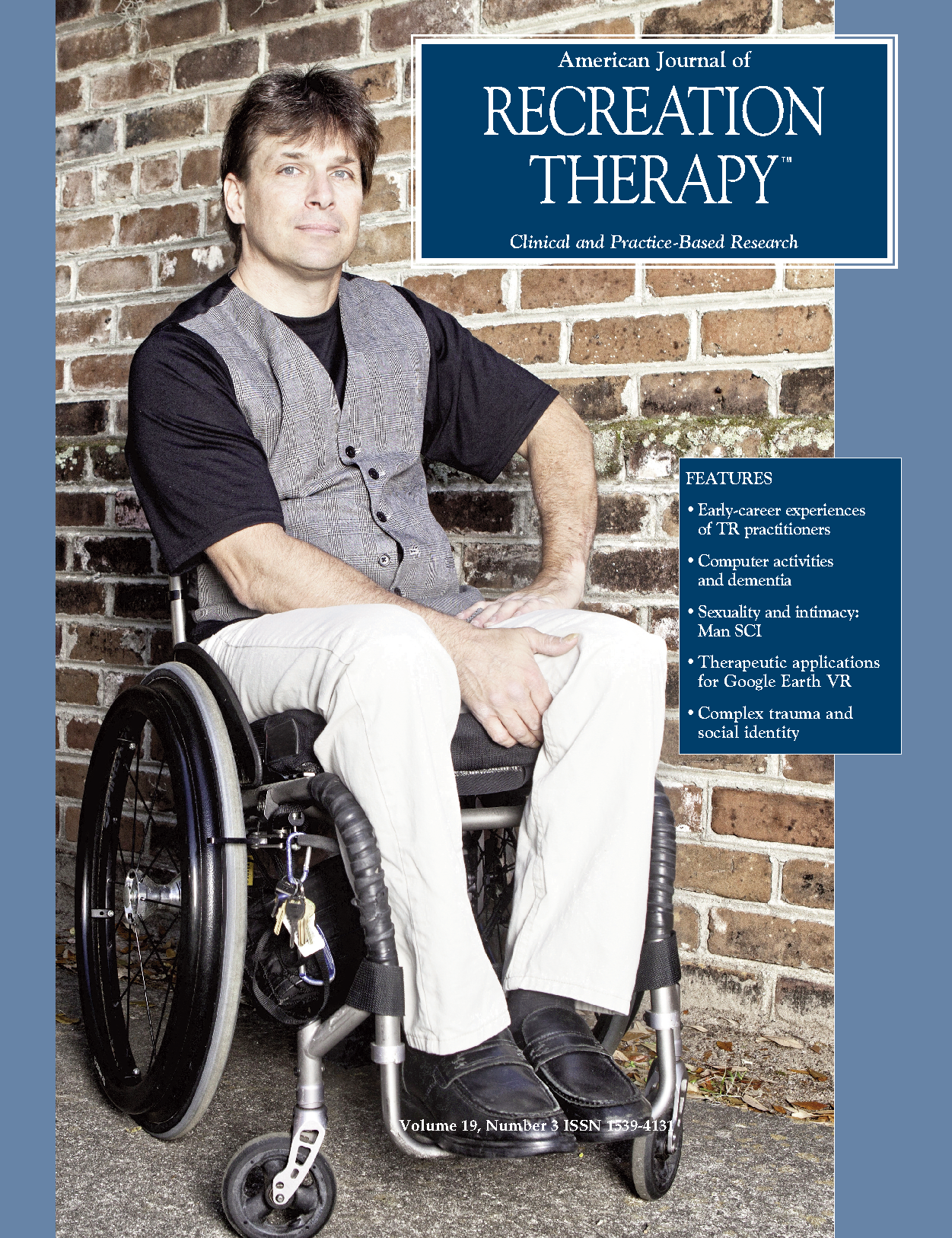The lived experience of sexual health and intimacy among men living with a spinal cord injury: The role of the recreational therapist
DOI:
https://doi.org/10.5055/ajrt.2020.0217Keywords:
sexual health, intimacy, spinal cord injury, recreational therapyAbstract
Sexual health and intimacy take on a new meaning for men after sustaining a spinal cord injury (SCI), biologically and psychologically. Yet, the majority of sexual health information provided during the rehabilitation process focuses on loss of muscle movement, erectile response, and orgasm with little therapeutic interventions focusing on intimacy, romantic relationships, and masculinity. This study employed semistructured interviews with seven men living with an SCI. The intent of this study was to better understand the lived experience of sexual health and intimacy among men living with an SCI. Phenomenological data analysis revealed three distinct themes: (1) clinical barriers, (2) internal barriers, and (3) intimacy with partner barriers concerning sexual health. The results from this study demonstrate a disconnect between the desire for sexual health and intimacy information and recreational therapy interventions.
References
Hachem LD, Ahuja CS, Fehlings MG: Assessment and management of acute spinal cord injury: From point of injury to rehabilitation. J Spinal Cord Med. 2017; 40(6): 665-675.
Gerschick T: Sisyphus in a wheelchair: Men with physical disabilities confront gender domination. In O’Brien J, Howard J (eds.): Everyday Inequalities: Critical Inquiries. London: Blackwell, 1998.
Pascoe CJ: Dude You’re A Fag: Masculinity and Sexuality in High School. Oakland, CA: University of California Press, 2007.
American Therapeutic Recreation Association: About recreational therapy. Available at https://www.atra-online.com/general/custom.asp?page=AboutRecTherapy. Accessed November 28, 2020.
Tallini A: Health is state of physical, mental, and social wellbeing. BMJ. 2011; 343: d5358.
World Health Organization: Health topics: Sexual health. Available at www.who.int/topics/sexual_health/en/. Accessed April 10, 2018.
Aykutog˘lu B, Uysal A: The relationship between intimacy change and passion: A dyadic diary study. Front Psychol. 2017; 8: 2257-2257.
Sternberg RJ: A triangular theory of love. Psychol Rev. 1986; 93(2): 119-135.
Leibowitz RQ, Stanton AL: Sexuality after spinal cord injury: A conceptual model based on women’s narratives. Rehabil Psychol. 2007; 52(1): 44-55.
Aikman K, Oliffe JL, Kelly MT, et al.: Sexual health in men with traumatic spinal cord injuries: A review and recommendations for primary health-care providers. Am J Mens Health. 2018; 12(6): 2044-2054.
Courtois F, Rodrigue X, Côté I, et al.: Sexual function and autonomic dysreflexia in men with spinal cord injuries: How should we treat? Spinal Cord. 2012; 50(12): 869-877.
Ibrahim E, Lynne CM, Brackett NL: Male fertility following spinal cord injury: An update. Andrology. 2016; 4(1): 13-26.
Sinha V, Elliott S, Ibrahim E, et al.: Reproductive health of men with spinal cord injury. Top Spinal Cord Inj Rehabil. 2017; 23(1): 31-41.
Kreuter M, Taft C, Siösteen A, et al.: Women’s sexual functioning and sex life after spinal cord injury. Spinal Cord. 2011; 49(1): 154-160.
Klein M: Sexual Intelligence: What We Really Want from Sex and How to Get It. New York, NY: HarperOne, 2012.
Mona LR, Krause JS, Norris FH, et al.: Sexual expression following spinal cord injury. NeuroRehabilitation. 2000; 15(2): 121-131.
World Health Organization: International Classification of Functioning, Disability, and Health (ICF). Geneva: WHO Publishing, 2001.
Mumford E: Wheelchair bound not sex bound: Reconstruction of self and sexual identity after spinal cord injury. Thesis. Minnesota State University, 2014.
Esmail S, Esmail Y, Munro B: Sexuality and disability: The role of health care professionals in providing options and alternatives for couples. Sex Disabil. 2001; 19(4): 267-282.
Otero-Villaverde S, Ferreiro-Velasco ME, Montoto-Marqués A, et al.: Sexual satisfaction in women with spinal cord injuries. Spinal Cord. 2015; 53(7): 557-560.
Piatt JA, Knee E, Eldridge L, et al.: Women with spinal cord injury and sexual health: The role of the recreational therapist. Am J Recreat Ther. 2018; 17(3): 25-35.
Snead B, Hsieh P-C, Snethen G: Sexual identity and discrimination: Creating a welcoming environment for sexual minority consumers. Ther Recreation J. 2016; 50(2): 172-175.
Piatt JA: The missing recreational therapy facilitation technique: Sexual health. Am J Recreat Ther. 2019; 18(3): 7-8.
Elliott S, Hocaloski S, Carlson M: A multidisciplinary approach to sexual and fertility rehabilitation: The sexual rehabilitation framework. Top Spinal Cord Inj Rehabil. 2017; 23(1): 49-56.
Porter H: Recreational Therapy Basics, Techniques, and Interventions. Enumclaw, WA: Idyll Arbor, 2016.
Fronek P, Booth S, Kendall M, et al.: The effectiveness of a sexuality training program for the interdisciplinary spinal cord injury rehabilitation team. Sex Disabil. 2005; 23(2): 51-63.
National Spinal Cord Injury Statistical Center: Facts and Figures at a Glance. Birmingham, AL: University of Alabama at Birmingham, 2019.
Elliott S, Jeyathevan G, Hocaloski S, et al.: Conception and development of sexual health indicators to advance the quality of spinal cord injury rehabilitation: SCI-high project. J Spinal Cord Med. 2019; 42 (Suppl. 1): 68-84.
Creswell JW: Research design: Qualitative, quantitative, and mixed methods approaches. Thousand Oaks, CA: SAGE Publications, 2014.
Cresswell JW, Poth CN: Qualitative Inquiry and Research Design: Choosing Among Five Approaches. 4th ed. Thousand Oaks, CA: Sage, 2018.
Starks H, Brown Trinidad S: Choose your method: A comparison of phenomenology, discourse analysis, and grounded theory. Qual Health Res. 2007; 17(10): 1372-1380.
Thrussell H, Coggrave M, Graham A, et al.: Women’s experiences of sexuality after spinal cord injury: A UK perspective. Spinal Cord. 2018; 56: 1.
Published
How to Cite
Issue
Section
License
Copyright 2000-2025, Weston Medical Publishing, LLC and American Journal of Recreation Therapy. All Rights Reserved.


